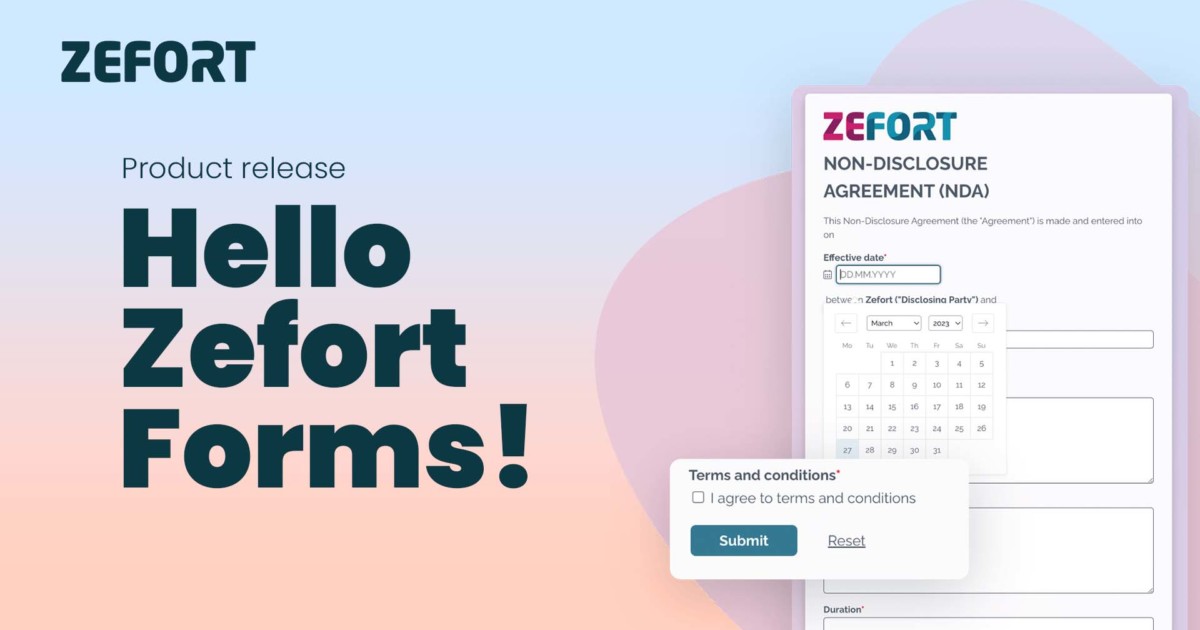Wait, why would anyone want to use handwritten signatures for electronic documents? Wasn’t it already time to throw away pens and paper and go all-in on simply tapping a button to sign a document?
Zefort Sign was recently updated with a feature that gives you the option of adding handwritten signatures to your digital signing request. With the feature, you can request the signer to add handwritten signatures, initials or a company stamp during the signing process.
Well, the handwritten signatures feature is based on customer requests – which goes to tell you that handwritten signatures are not dead. Read on to discover when, where and why you might still want to sign on the dotted line!
Good to know: Adding handwritten signatures is an option that you can choose individually for each signing request. The normal secure digital signature created by Zefort Sign is not affected in any way; the handwritten signature acts as a visual enhancement.
#1 Add prestige with handwritten signatures
Not all signing events call for turbo-optimized efficiency. Imagine you’re finalizing a deal where an entrepreneur is selling her life’s work to the next generation – it’s an unforgettable, emotional event.
Signing an important document can sometimes still hold ritual importance that signifies a monumental agreement or commitment to a shared goal. Visualize two heads of state finalizing a partnership agreement between two nations – that event and those signatures end up in news headlines around the world.
Even though you’re not inking deals on global relations on an everyday basis, handwritten signatures can add a personal touch to those special moments you may come across.
#2 Control the signing process
With the new Zefort Sign feature, you are not limited to adding a single handwritten signature field to the end of the document. In fact, you can add as many mandatory fields for signatures, initials or stamps as you want – anywhere in the document.
This means that you can control the signing event in great detail.
You can, for example, require the signer to add her initials on every page of the document. Or, place the mandatory field on a few select sections.
This lets you ensure that the signers have paid attention to the sections of the document you want to emphasize – and not just simply scroll down quickly to the signing button.
#3 Meet local signing customs and traditions
Traditions and customs are different between various countries around the world – and even between companies. Some areas or organizations are just transitioning from paper-based processes to digital processes.
Case in point: there are still numerous countries, industries and businesses that require you to add your company’s stamp on a contract.
No matter if its a personal preference or a local tradition, Zefort Sign’s new feature lets you easily meet this requirement, no matter if it’s a signature or a visual stamp of your company’s logo.
#4 Comply with national signature regulations
Expanding on the previous point, digital signing solutions may not be widely used everywhere
or a digital signatures’ position as a legally binding signature may not be clear.
In some countries or cultures, a handwritten signature may be perceived as more legally or culturally binding than a purely digital one. Zefort Sign’s new feature may help you bridge that gap without resorting to sending printouts in mail or setting up a physical signing meeting.
However, if you’re working outside the EU (where electronic signatures are legally binding), remember to check the local regulations for legally binding signatures. Handwritten signatures in digital documents just may solve your problem.
#5 Add emotional engagement
The method of how you sign a document may have psychological implications, too. From a mental point of view, it’s more engaging to enter your name instead of just pushing a button.
The act of physically signing one’s name can create a stronger psychological sense of commitment and agreement to the document’s terms, enhancing the signer’s sense of responsibility.
Further, handwritten signatures can evoke a stronger emotional response, making documents feel more meaningful and engaging, particularly in personal contexts like an employment contract or a certificate.






